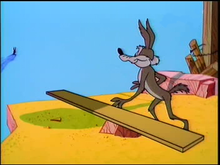Hare-Breadth Hurry
| Hare-Breadth Hurry | |
|---|---|
 Screenshot from the short | |
| Directed by | Chuck Jones Maurice Noble (co-director) |
| Story by | John Dunn |
| Starring | Mel Blanc |
| Edited by | Treg Brown |
| Music by | Bill Lava |
| Animation by | Tom Ray Ken Harris Richard Thompson Bob Bransford Harry Love (effects animation) |
| Backgrounds by | William Butler |
| Color process | Technicolor |
Production company | |
| Distributed by | Warner Bros. Pictures |
Release date |
|
Running time | 7 minutes |
| Language | English |
Hare-Breadth Hurry is a 1963 Warner Bros. Looney Tunes cartoon directed by Chuck Jones and Maurice Noble.[1] The cartoon was released on June 8, 1963, and stars Bugs Bunny and Wile E. Coyote.[2]
Plot
[edit]Wile E. Coyote is in pursuit of Bugs Bunny, who temporarily fills in for an injured Road Runner. Utilizing Acme Super Speed Pills to emulate the Road Runner's velocity, Bugs finds himself momentarily matching the speed of his pursuer, only for the pills to abruptly wear off, leaving him vulnerable.
Forced to rely on his cunning, Bugs employs various tactics to outsmart Wile E. Coyote, including a clever ruse involving drawn lines on the road, a makeshift fishing endeavor, and a rigged catapult. Despite Wile E.'s persistent efforts, he repeatedly falls victim to Bugs' inventive stratagems, leading to comical yet predictable outcomes.
As the chase ensues, Bugs orchestrates elaborate traps, capitalizing on Wile E.'s relentless pursuit. Employing ingenious devices and exploiting the coyote's penchant for contraptions, Bugs consistently outmaneuvers his adversary, culminating in a series of calamitous yet humorous mishaps.
Production notes
[edit]In Hare-Breadth Hurry the fifth and concluding collaboration between Bugs Bunny and Wile E. Coyote, a departure from the conventional formula is observed. Unlike its predecessors, this cartoon adopts the familiar framework of the Wile E. Coyote and Road Runner series, with Bugs Bunny assuming the role typically occupied by the Road Runner. Wile E. Coyote remains silent, while Bugs Bunny frequently addresses the audience, a departure from the customary interaction between characters.
Notably, Hare-Breadth Hurry stands out as one of the rare instances where Bugs Bunny abstains from consuming a carrot, a recurring motif in many of his appearances, although Wile E. Coyote employs carrots as a lure in his pursuit of Bugs.
See also
[edit]References
[edit]- ^ Beck, Jerry; Friedwald, Will (1989). Looney Tunes and Merrie Melodies: A Complete Illustrated Guide to the Warner Bros. Cartoons. Henry Holt and Co. p. 343. ISBN 0-8050-0894-2.
- ^ Lenburg, Jeff (1999). The Encyclopedia of Animated Cartoons. Checkmark Books. pp. 60–62. ISBN 0-8160-3831-7. Retrieved 6 June 2020.
External links
[edit]- 1963 films
- 1960s English-language films
- 1963 animated films
- 1963 short films
- Looney Tunes shorts
- Warner Bros. Cartoons animated short films
- Short films directed by Chuck Jones
- Wile E. Coyote and the Road Runner films
- Films directed by Maurice Noble
- Films scored by William Lava
- Self-reflexive films
- Bugs Bunny films
- 1960s Warner Bros. animated short films
- American animated short films
- American comedy short films
- Films with screenplays by John Dunn (animator)
- Animated films set in deserts
- English-language short films
